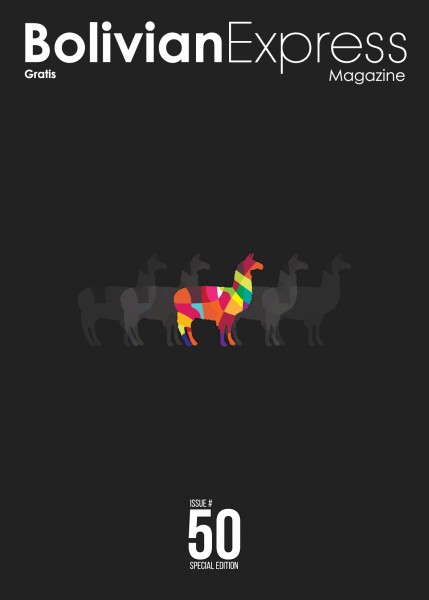
Five years ago Bolivian Express was born between a japanese restaurant and a lift on Avenida 20 de Octubre in La Paz. During the clunky journey from the ground floor to the 17th storey, two young gentlemen and a Swiss-Indian chica lamented the absence of an English-language publication in the country; two notable predecessors—the Bolivian Times and Llama Express—were sadly no longer in circulation. And so the name of the magazine was born as a portmanteau of sorts, an homage to the magazine’s forebearers.
We were determined to find a viable way of printing a quality free publication, given the erratic nature of local advertising revenues and shortage of local English-language journalists. A further (Irish) founder was enlisted and six university friends were boarded on a plane, kidnapped to serve as editorial guinea pigs. It became clear to the founding team that an ideal way of sustaining the project as a whole would be to combine it with a journalism training programme.
What started off as a magazine for tourists quickly turned into something else. After the first 10 issues, we had already covered all the well-trodden festivities and attractions the country is probably best known for. The continuous challenge has been to find new stories from which everyone, including the local audience, can learn something new. Indeed, over half of our readers are native Spanish speakers, so we are as committed to writing for them as we are for the uninitiated in Bolivia. This work has brought us close to people we would perhaps never have had an excuse to get to know: from former presidents, ministers and local sporting heroes, to Michael Jackson impersonators, prisoners serving life sentences and private investigators.
Since our unconventional beginnings, the project has involved over 120 people from 20+ countries worldwide who have come to volunteer as part of the effort.Today, the Bolivian Express team of volunteers live and sleep in a shared house as they explore the country, its stories and cultures with the help of a local team. By looking beyond the salt-flats and ancient ruins, their mission is to bring new eyes to this infinite land. If they leave as cultural ambassadors, rather than just tourists, the project has achieved one of its aims. And, of course, by flicking through these pages you, the reader, are closing the circle and helping to complete this project’s mission.
Over the years we have also worked with a large number of people across the world: editors scattered across San Francisco, New York and Caracas, a web developer in Berlin, an editor and marketing director somewhere in the Swiss alps, and even a virtual assistant in Bulgaria (hey, Pavlin). As past team members have taken on new challenges, others have appeared and have reshaped the project anew. With this, our 50th issue, we are incredibly proud to say that Bolivian Express has a life of its own; it exists as something greater and wiser than the people who have made it possible so far.
Thank you for being a part of this journey.
ILLUSTRATION: MARCELO VILLEGAS
Against a backdrop of half-finished houses and buildings fashioned from exposed red brick, El Alto's Neo-Andean Cholets are almost impossible to ignore. From their blindingly bright exteriors to their experimental proportions, these vibrant constructions are the architectural antithesis to the surrounding cityscape. While each creation has a unique identity, the buildings are stylistically linked through their use of Andean motifs - be it a Chakana cross above a doorway or a mural of a condor. This nod to indigenous heritage and the cholets' impressive price-tags make these mini-mansions especially appealing to El Alto's emerging Aymara bourgeoisie.
PHOTO: MICHAEL DUNN CACERES
What is it you seek? Be it love, money, or even a new car, you are free to pursue your desires at the annual Alasita festival in La Paz. Each January, the chaotic city streets are transformed to an expansive marketplace. The produce on offer? Desires, but in miniature form.
Stalls on the streets are piled high with tiny toy cars, tiny houses, tiny bottles of alcohol and monopoly-sized money. A Yatiri, or traditional Aymaran healer, blessed your chosen miniatures. This blessing will hopefully make your miniature manifest itself as a tangible life-size possession in the coming year.
Presiding over the festival is a jolly and rosy-cheeked Tiwanakan God of abundance, Ekeko. Clad in traditional Aymaran garb, the Ekeko figurines take centre stage at the festival. After the miniatures have been blessed, they are hung upon the figures as an offering.
Cholitas, school children and business professionals flock in the hundreds to snatch up the tiny objects. This folkloric event is alive at the heart of a rapidly modernising city.
Photo: Valeria Wilde
Welcome to El Alto Market, the famous open-air marketplace of La Paz’s looming sister city, where you can find just about everything you never knew you wanted. Like nearly everyone who sets foot into its colorful hustle and bustle, we BX-ers have had our fair share of odd experiences at the market. We’ve discovered (and found ourselves oddly drawn to) promised medicinal remedies such as bottled snake butter, snail slime and cat nails. We’ve caved in to buying a DVD about extraterrestrial “Reptilianos en Bolivia”, and a live llama, which, to our disappointment, we later discovered was just a sheep. We’ve come close to finding all the parts we’d need to construct our own functioning car, and have spent hours picking through piles of used clothing, aka El Alto’s own Urban Outfitters. As a place where bartering is expected, just about the only rule is that you leave with something you didn’t come for in the first place.

 Download
Download





















